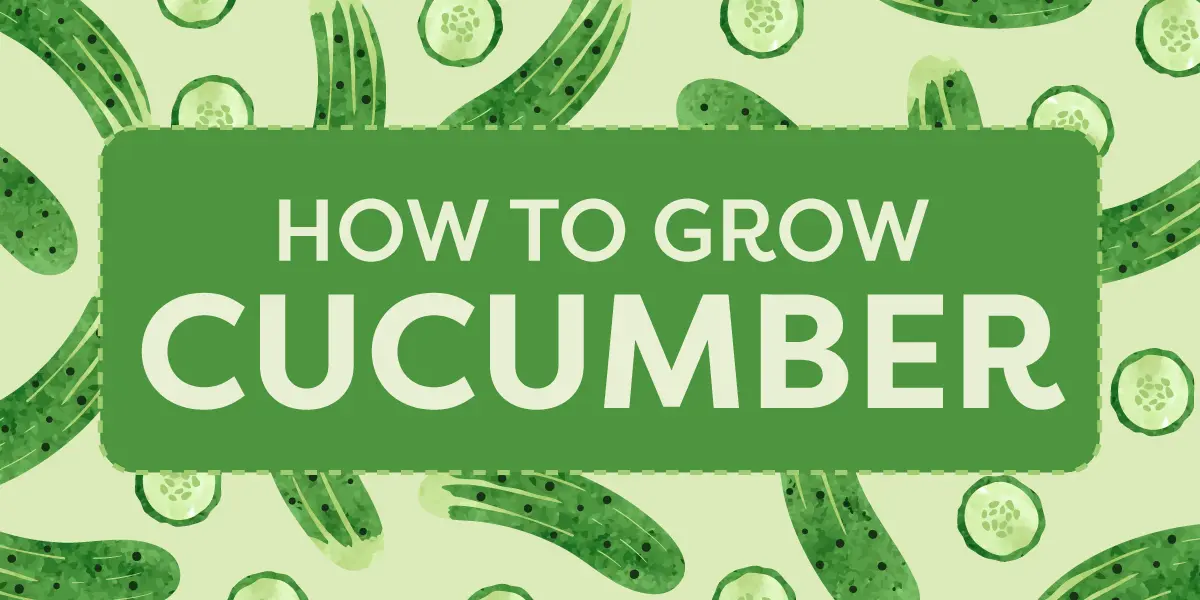Cucumbers belong to the gourd family. Like all gourds, they grow in trailing vines and thrive in warm climates.
Some gourds become containers, musical instruments, or decorations. The cucumber makes a lousy harp, but a peerless pickling vegetable.
The vines are easy to cultivate in Southern California’s Mediterranean climate, but need proper care to produce abundant harvests.
Straight from the garden, the fruit is crisper, juicier, and more flavorful than store-bought produce.
Selecting the Right Variety
Cucumbers fall into two main categories: slicing and pickling.
- Slicing cucumbers are larger and have thicker skin.
- Pickling cucumbers are smaller with thinner skin.
Within these categories are different types of cucumbers, such as English, Persian, and Japanese. Each has its own flavor profile and texture.
- English cucumbers are long and thin, with a sweeter taste and fewer seeds. Also known as seedless or hothouse cucumbers, these are the most popular variety with American grocery shoppers.
- Persian cucumbers are shorter and thick, with a crisp texture and more seeds. They produce abundant yields.
- Japanese cucumbers are smaller and thinner than English and Persian cucumbers, with a slightly sweeter taste.
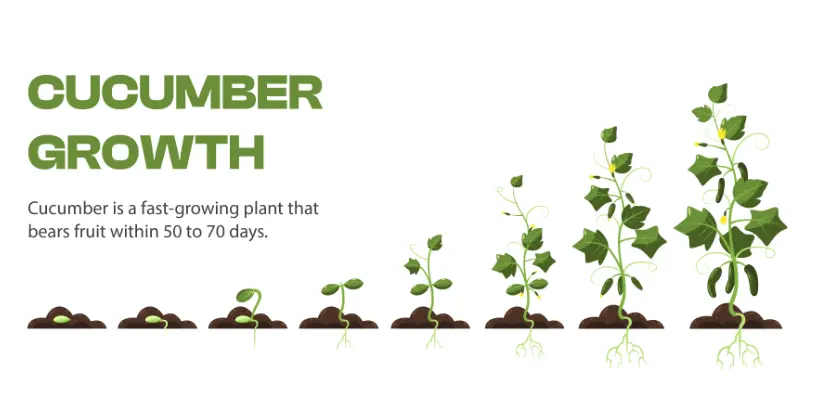
The stages of cucumber plant growth. Plants can reach maturity in less than two months.
Seed or Transplant?
Cucumbers are fast-growing plants. Starting from seed is a viable option, but you can also transplant seedlings into your garden to get a head start on the growing season.
Starting Cucumbers from Seeds
- Choose a Sunny Spot: Cucumbers thrive in full sunlight and well-drained soil. Find a location that receives at least 6 to 8 hours of direct sunlight daily.
- Prepare the Soil: To improve fertility, amend the soil with compost or well-aged manure. The soil should be loose and well-draining.
- Adjust the Soil pH: Cucumbers perform best in soil with a pH range of 6.0 to 6.8. Use a soil test kit to determine your garden’s pH level. Add lime to raise it or sulfur to lower it.
- Plant the Seeds: Sow cucumber seeds directly into the ground when the soil temperature exceeds 70°F. Plant seeds about 1 inch deep in groups of 2-3 seeds, spacing the groups about 18 inches apart.
- Water Gently: Keep the soil moist but not soaked. Watering with a gentle spray prevents the seeds from washing away or getting buried too deep.
- Thin the Seedlings: When the seedlings are about 4 inches tall, thin them to leave the most robust plant in each group. This ensures adequate space and resources for the remaining plants.
Starting with Transplants
- Select Healthy Seedlings: Choose cucumber plants that appear strong, vibrant, and free of pests or diseases. Avoid overcrowded seedlings, which may have stunted growth.
- Harden Off the Seedlings: Gradually acclimate your cucumber seedlings to outdoor conditions over 7 to 10 days. This process reduces transplant shock and improves their chances of survival.
- Transplant Carefully: Plant the seedlings in your prepared garden bed, spacing them about 18 inches apart. Dig a hole larger than the root ball, gently place the seedling in, and refill the hole. Press down the soil around the base of the plant.
- Water Immediately: Water the new transplants deeply to help settle the soil and give seedlings needed moisture.
Watering & Fertilizing
Watering
- Cucumbers need consistent moisture to produce juicy fruits. Water your cucumbers once or twice a week, applying 1 to 2 inches each time.
- The best time to water cucumbers is in the early morning. This allows the water to reach deep into the soil before the day’s heat accelerates evaporation.
- Apply a layer of organic mulch around your cucumber plants to retain soil moisture and keep the roots cool.
Fertilizing
- Apply a balanced, all-purpose fertilizer when planting to give your cucumbers an early boost.
- Fertilize cucumbers every 4 weeks with a nitrogen-rich fertilizer to support their rapid growth and fruit production.
- The best time to fertilize cucumbers in Southern California is in the late afternoon or early evening. This reduces the risk of burning the plants.
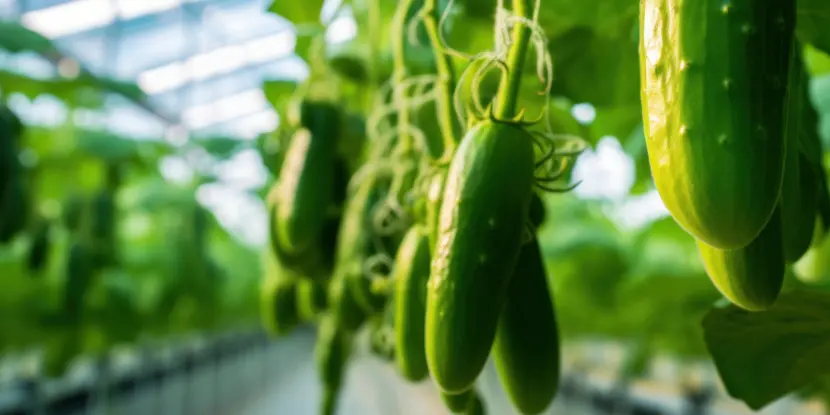
Cucumbers growing in a greenhouse.
Temperatures
Cucumbers flourish in warm conditions, with an ideal temperature range between 70°F and 90°F during the day.
At night, temperatures stay above 60°F.
Some afternoon shade can be beneficial in regions with intense summers. Shielding cucumbers from the hottest part of the day preserves moisture, reduces the risk of sunscald, and ensures the plants continue producing crisp, flavorful fruits throughout the season.
Supporting Cucumber Vines
Support structures like trellises and cages help manage plant growth, keep fruits off the ground, and promote better air circulation around the plants.
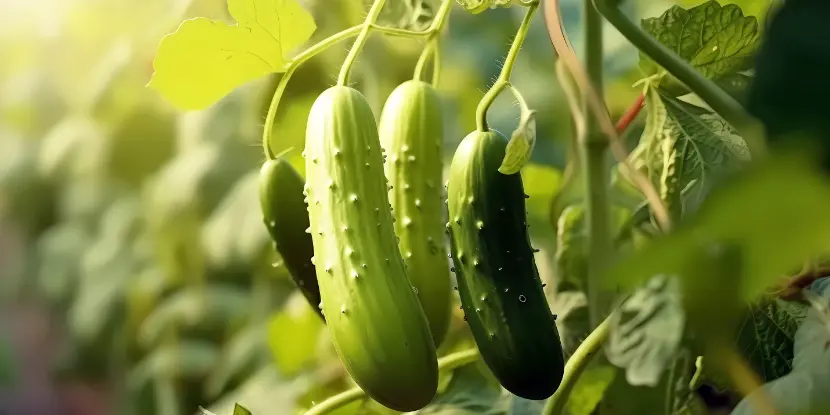
Cucumbers ready for harvest.
Why Use Trellises or Cages
- Improved Air Circulation: Leaves and fruits stay off the ground, reducing disease risk and improving air circulation.
- Cleaner, Straighter Fruit: Fruits are less likely to be affected by soil-borne diseases or pests.
- Space Efficiency: Vertical growth maximizes garden space, allowing for more plants.
- Easier Harvesting: The fruit of trellised plants is more visible and accessible, making harvesting simpler and less damaging to the plant.
Setting Up Support for Your Cucumbers
- Select a trellis, cage, or sturdy netting to support the weight of fully-grown cucumber plants laden with fruit. Trellises can be made of wood, metal, or plastic.
- Installation at the time of planting or shortly after prevents damage to the growing root systems and vines.
- Place the trellis or cage directly behind the planting site and anchor it in the ground.
- Guide the young cucumber vines toward the support structure. You may need to tie the vines loosely with garden twine to train them upward.
- Optional pruning of lower leaves can further improve air circulation and ease of harvest, especially in dense plantings.
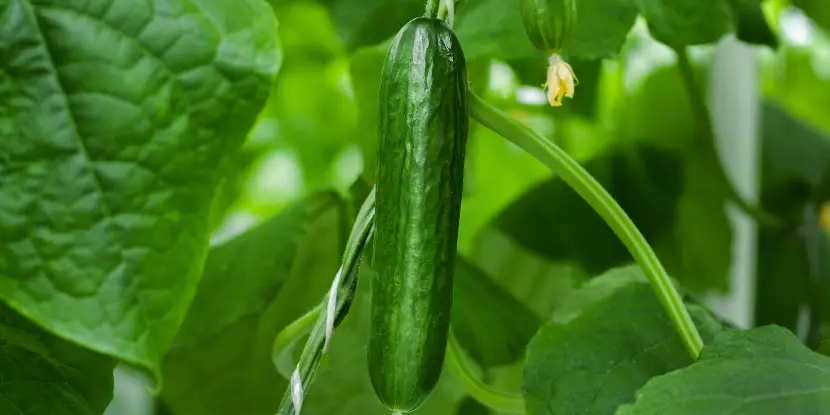
When cucumber plants are supported by a trellis, the fruit grows straighter and cleaner.
Managing Pests & Diseases
Aphids, cucumber beetles, and spider mites are common pests in Southern California, while powdery mildew and downy mildew are prevalent fungal diseases. Try the following strategies to manage them organically:
Organic Pest Control
- Neem Oil: Safe for use on vegetables, neem oil can deter aphids and spider mites. It acts as an antifeedant, growth regulator, and repellent.
- Insecticidal Soap: Effective against soft-bodied insects, insecticidal soaps can be sprayed directly onto pests without harming the plant.
- Companion Planting: Planting marigolds or calendula around cucumbers can repel cucumber beetles and other pests.
Organic Disease Management
- Baking Soda Spray: A homemade fungicide consisting of baking soda, water, and a small amount of liquid soap can control powdery mildew. This mixture alters the pH on leaf surfaces, making it less hospitable for fungal growth.
- Proper Spacing and Pruning: Ensure adequate air circulation around plants and prune overcrowded areas. This reduces humidity, a primary factor in the development of mildew.
- Milk Spray: Spraying a mixture of milk and water on cucumber leaves can prevent the spread of powdery mildew. The proteins in milk have antiseptic properties that inhibit mildew growth.
Container Cultivation
Container gardening is a primo option when you have limited space. It can even reduce the risk of soil-borne diseases. Here’s how to make it succeed:
- Containers should be at least 12 inches deep and wide. They should have drainage holes at the bottom.
- Use a well-draining, nutrient-rich potting mix for vegetable gardening. Avoid garden soil, which may drain poorly and contain pathogens.
- Opt for compact or bush cucumber varieties that perform well in containers.
- Sow seeds directly into the potting mix, 1 inch deep. Alternatively, transplant seedlings, taking care not to disturb the roots. Space plants about 6 to 8 inches apart in larger containers, or plant one per pot in smaller containers.
- Containers dry out faster than garden soil. Water when the top inch of the potting mix feels dry. Aim for even moisture without saturating the soil.
- Provide support with a small trellis or stake to encourage vertical growth and save space.
- Container plants require frequent feeding due to the limited nutrients in potting mix. Apply a balanced liquid fertilizer every 2 weeks, following the product’s recommendations.
- Position containers where plants receive at least 6 to 8 hours of direct sunlight daily.
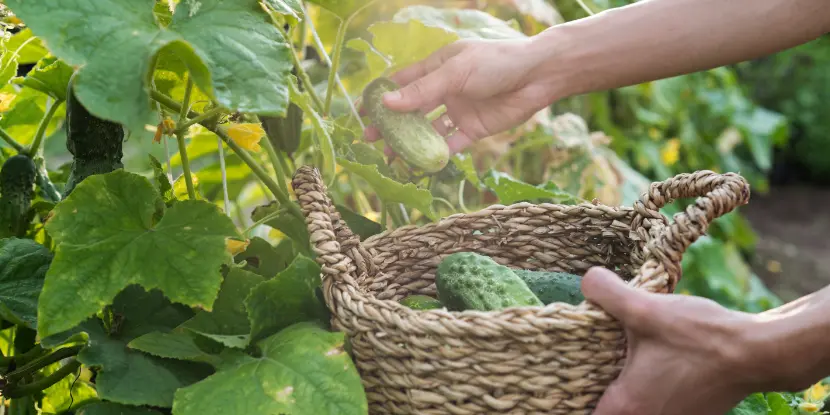
Harvesting cucumbers from the garden.
Harvesting Cucumbers
The harvest begins 50 to 70 days after planting, depending on the cucumber variety and growing conditions.
- Most salad cucumbers are ready for harvest when they reach 6 to 8 inches long. For pickling cucumbers, 3 to 5 inches is optimal.
- Look for a firm texture and bright, even color. Pickling varieties should be firm and green, without yellow spots.
- Check plants every other day, as cucumbers grow fast. Regular harvesting encourages more production.
Steps for Harvesting Cucumbers
- Harvest in the morning when temperatures are cooler. This ensures crispness and prevents wilting.
- Cut the cucumber from the vine using garden shears or a sharp knife. Avoid twisting or pulling, which can damage the plant and fruit.
- Hold the cucumber vine in one hand and cut the stem just above the cucumber. This gentle approach preserves the integrity of the plant and fruit.
- Keep harvesting mature cucumbers to encourage new growth. Overripe cucumbers left on the vine can signal the plant to stop producing.
FAQs: Growing Cucumbers
Q: How long does it take for cucumber seeds to germinate?
Seeds typically germinate within 7-10 days when provided with adequate warmth and moisture.
Q: Do cucumbers require pollination to produce fruit?
Most varieties require pollination. Bees and other pollinators are essential for fruit production.
Q: What’s the best time of day to water cucumber plants?
It’s best to water cucumber plants in the morning. This reduces the risk of fungal diseases and ensures plants are hydrated before the day’s heat.
Q: How often should I harvest cucumbers?
Harvest cucumbers regularly to encourage continued fruit production. Check plants every 2-3 days and harvest mature cucumbers promptly.
Q: Can cucumbers be grown in shade?
Cucumbers prefer 6 to 8 hours of direct sunlight per day. While they can grow in partial shade, the yield and plant health may be compromised.
Q: Is it necessary to rotate cucumber crops each year?
Rotating cucumber crops helps prevent soil-borne diseases and pests. We advise against planting cucumbers in the same spot more than once every three years.
Q: How do I know if my cucumbers are overwatered?
Signs of overwatering include yellowing leaves, soft and mushy spots at the base of the plant, and a general droopiness. Overwatering can lead to root rot. Always allow the soil to dry slightly between waterings.
Q: Can cucumbers be grown next to tomatoes?
Yes, but because both plants cast significant shade, space them appropriately for adequate sunlight.
Q: What should I do if my cucumber leaves turn yellow?
Yellowing leaves can indicate a nutrient deficiency, usually nitrogen, or overwatering. Evaluate your watering schedule and consider a soil test to determine if your plant needs supplemental fertilizer.

